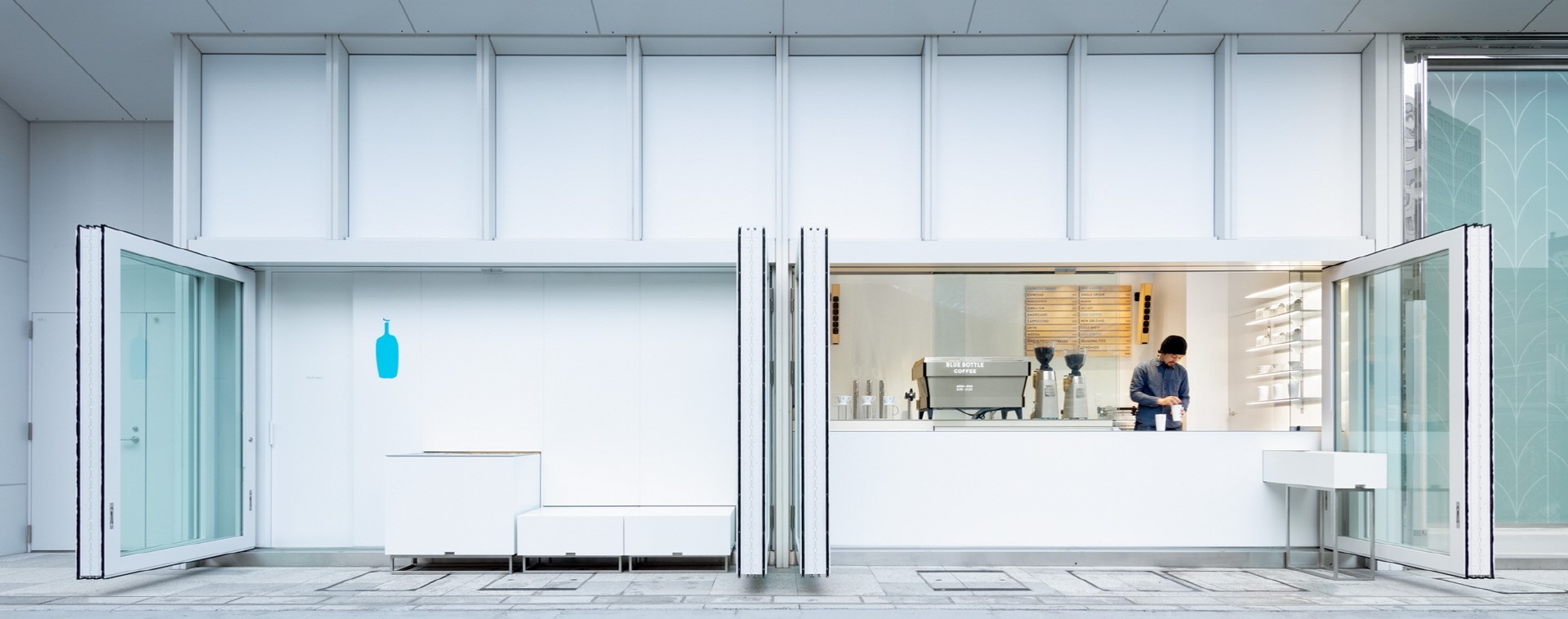SPACE May 2023 (No. 666)
Phenomenon 1. Becoming the Purpose of the Visit
Phenomenon 2. Connecting Residents and Communities
Phenomenon 3. Weaving an Experience
In an era in which we find the word ‘experience’ attached to everything from our economy, consumption, design, and marketing, the cafés of today are asked to provide something more innovative, more unique, more detailed, and more beautiful than the usual experience of drinking coffee. This is particularly true if we are referring to a city context in which we see myriad cafés daily crowded with people, many of whom can only afford the limited time in their busy schedules to nip to a café instead of escaping the city altogether. In light of this, what is the role of the architect? As a collaborator with Blue Bottle Coffee which is currently expanding its services with branches in various international cities, Nagasaka Jo (principal, Schemata Architects) is responsible for devising the spatial experience of the brand. Likewise, THE FIRST PENGUIN, Fabrikr, COM, and nendo are design studios that are sculpting unique café experiences within the city not only via architectural features but also through various tools such as planning, branding, furniture, and art. In Phenomenon 3, reaching beyond the architect’s framework, we will listen to the stories behind these cafés and come to understand their own special means of survival in the city.
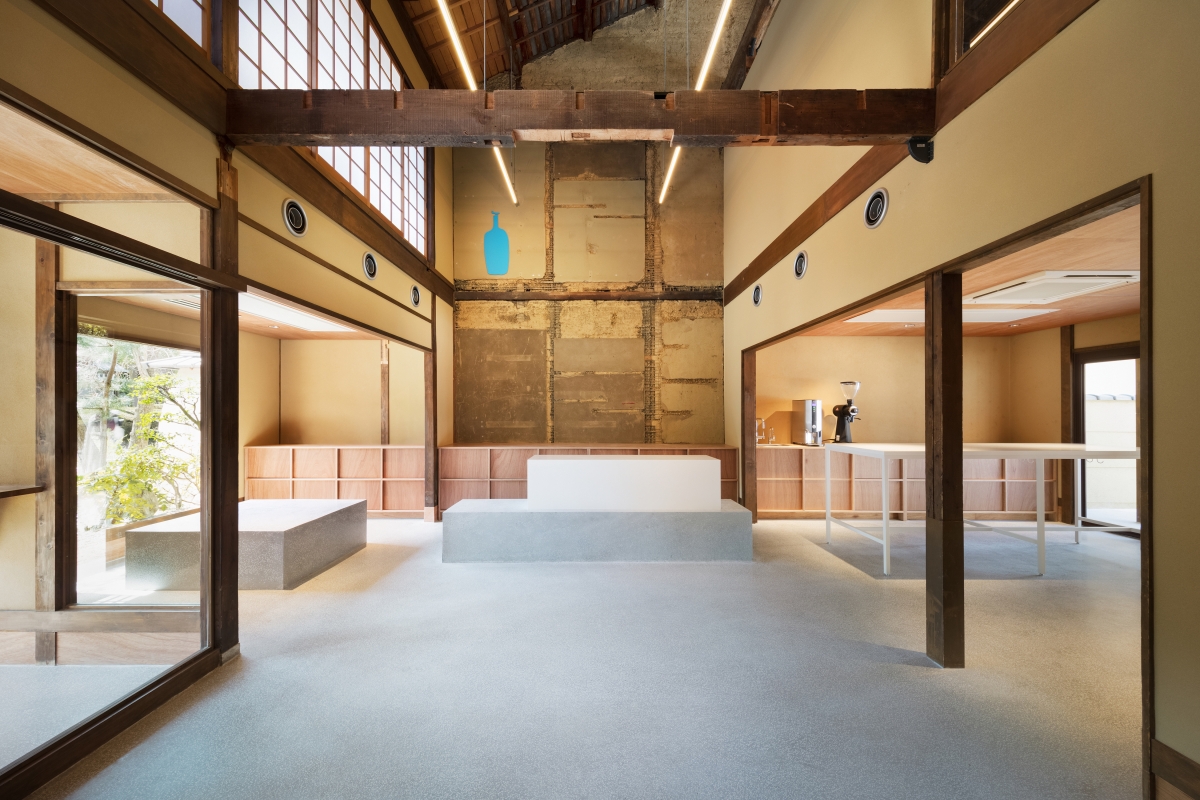
Blue Bottle Coffee Kyoto Cafe
Creating a Brand Experience in Café: Blue Bottle Coffee and Nagasaka Jo
In the same way that one goes travelling or shopping, the number of people searching for an unusual café experience has increased. As people schedule their weekends, making dinner plans or slotting in coffee with friends, one might expect to google ‘cafés with a good atmosphere’ which would probably not offer up chains like a Starbucks or The Coffee Bean & Tea Leaf. So commonplace nowadays, these café franchises, while convenient and familiar, are instead expected to provide the expected experience. But what about Blue Bottle Coffee, another large chain, that first set foot in the Korean market in 2019? Let’s find out more by reviewing the work of architect Nagasaka Jo (principal, Schemata Architects), who have designed more than 20 Blue Bottle Coffee stores in Japan, Korea, and China, since 2015.
Blue Bottle Coffee and Space
Blue Bottle Coffee (hereinafter Blue Bottle), was founded in 2002 in Oakland, California, and has established a distinguished coffee identity for itself by pursuing a connection with its local communities and serving coffee made with care from fresh beans, even if it means a slower and less efficient process. It had been expanding its reach across the US and Japan, and has now become a major competitor to other chains by opening locations in major cities such as Seoul, Hong Kong, and Shanghai. If Starbucks is about providing the same ambience and quality in terms of space in whichever city or country you find yourself, Blue Bottle is about showcasing a café space that, along with the unique aesthetics of its brand, can embody the unique character of the region. This is one of the reasons why Blue Bottle receives so much interest whenever it opens a café in a new region. On May 2019, when Blue Bottle opened its first Korean café in Seongsu-dong, the long waiting line filled the entire building from the early morning of its opening, demonstrating the scale of this interest. For the people who had long awaited the opening of Blue Bottle in Korea, the target of their anticipation was not just Blue Bottle’s coffee but its café space. Among the architects and designers that Blue Bottle closely collaborates with for many of its cafés, the Japanese architect Nagasaka Jo is one of its main partners. Starting with the Blue Bottle Coffee Kiyosumi Shirakawa Flagship Cafe (2015, 2019), its first café in Japan, Nagasaka has designed almost all of its cafés in Japan as well as the Seongsu Cafe (2019) and Samcheong Cafe (2019) in Korea and even some of the cafés in China. How did Nagasaka express Blue Bottle’s brand identity in these different spaces?
Matching Hospitality with Communication
The keyword for Blue Bottle as a brand is ‘hospitality’. Japan’s coffee culture was a major influence for James Freeman – the founder of Blue Bottle – and Blue Bottle’s brand direction. The coffee culture of kissaten where the barista is asked to communicate with the customer, choose the beans, brew the coffee, and serve it with care, has become the backbone of Blue Bottle’s operation method. Nagasaka drew out this sense of equality and communication from the spirit of hospitality. First, by perceiving ‘the fair coexistence of beans, barista, and customer as Blue Bottle’s identity’, Nagasaka focused on adjusting the floor heights in all cafés to keep those three elements at the same eye level. While it is normal that coffee bar space is slightly elevated due to the plumbing equipment underneath, here Nagasaka deliberately restructured the floors however as the height disparity creates separation between the barista and the customer. As an example, in his Kyoto Cafe (2018) which was the renovation project of a century-old traditional Japanese house called machiya, Nagasaka demolished the original floor which was elevated at about 50cm to create a new level floor surface that matched the outside. The materials between the exterior and interior were distinct, but by using terrazzo on the interior floors with the same gravel material found outside, a visual continuity was maintained. The floor inside the café emerges almost unexpectedly to function as benches and tables. Furthermore, as a part of his consideration of hospitality, all furniture heights were kept under waist level so that they would not act as visual or physical obstacles between service and customers. Nagasaka also understood that visual communication is formed through the exchange of eye contact as an important language of hospitality. For example, when designing a café of two or more floors, he either removed a part of the slab or replaced it with glass to create a visual connection between the floors and thereby allow the staff to observe the customers enjoying their coffee and the customers to likewise watch the staff drawing their coffee, dispensing the samples, and roasting the beans. This feature can be found in Kiyosumi Shirakawa Flagship Cafe, Kyoto Cafe, Seongsu Cafe, Nakameguro Cafe (2016), among others. On this point, Nagasaka explained that this is about building a positive relationship of ‘seeing and being seen’ where people can perceive each other wherever they might be in space.
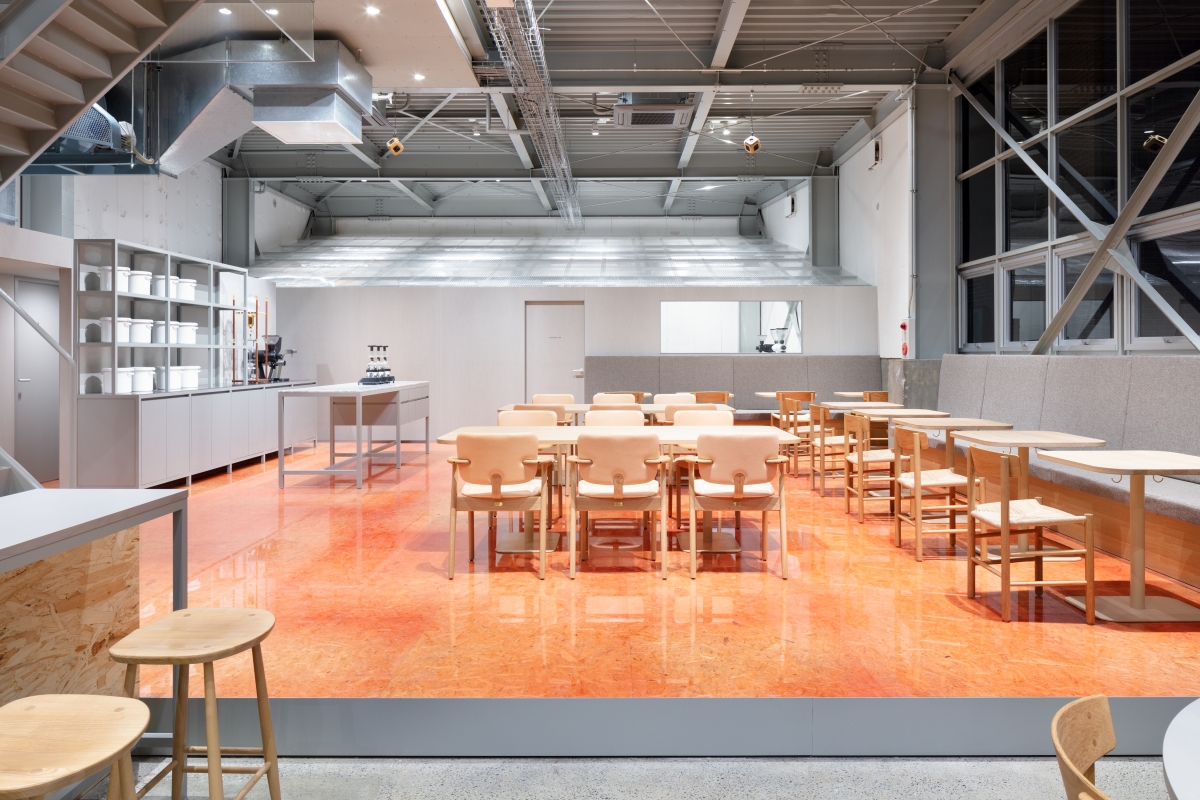
Blue Bottle Coffee Kiyosumi Shirakawa Flagship Cafe
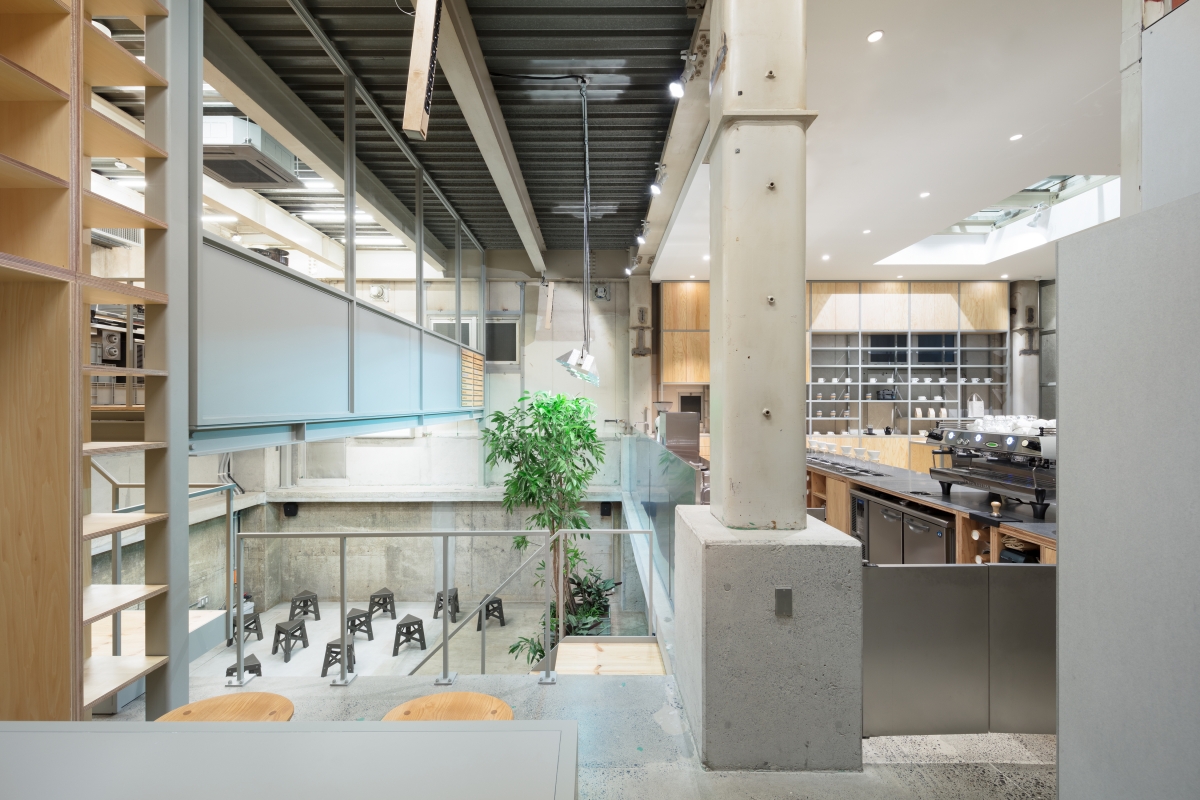
Blue Bottle Coffee Nakameguro Cafe
Traces of Regionality
Another keyword emphasised by James Freeman is ‘simplicity’. Blue Bottle’s spaces must have a calm background that do not disturb the core experience—that is, enjoying coffee. In line with this, instead of filling up the empty spaces with colours, patterns, panels, banners, and objects, Nagasaka chose to leave them untouched. Because of this, the traces of past histories are often preserved in his cafés even after their completion. As an example, one might consider the Kiyosumi Shirakawa Flagship Cafe which used to be a warehouse, or the Nakameguro Cafe which used to be a factory, or Sangenjaya Cafe (2017) which used to be a clinic. This coincides with Blue Bottle’s priorities when deciding its café locations—that is, privileging harmony with the local region and preservation of local memories. The bare space that unabashedly reveals the past traces via minimal architectural intervention builds trust among the locals and provides a novel experience to the newcomers. For example, in Kyoto Rokkaku Cafe (2019) which used to be a two-floor traditional machiya that also housed a bicycle shop for generations that span over a century, the traditional lattice frame windows and sliding doors, the handrails made of Japanese cedar wood, and the glass-partitioned bicycle shop which is still in business on the first floor can all be found there. In his aim to ‘create a space that highlights and harmonizes with the region instead of standing out’, rather than going with the typical colour palette of Blue Bottle, Nagasaka colored the Kyoto Rokkaku Cafe with dark brown tones to have it meld into its surrounding context as a small local café.
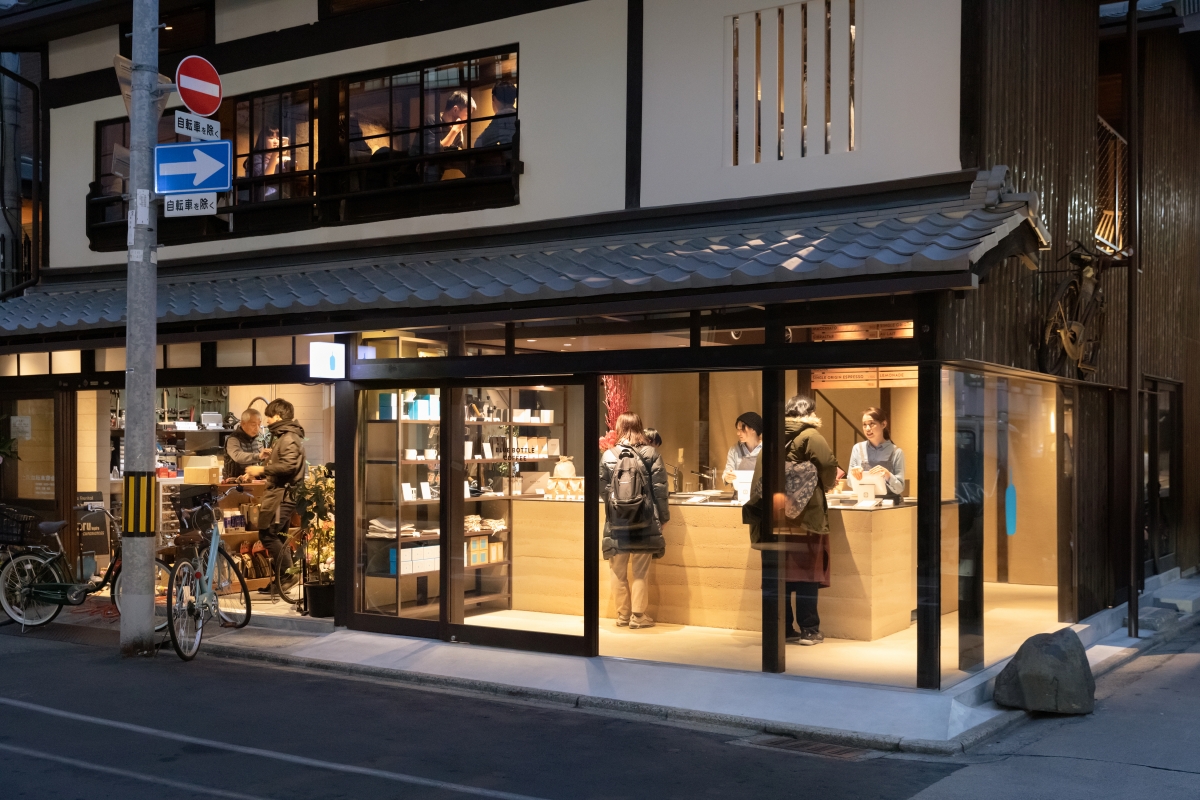
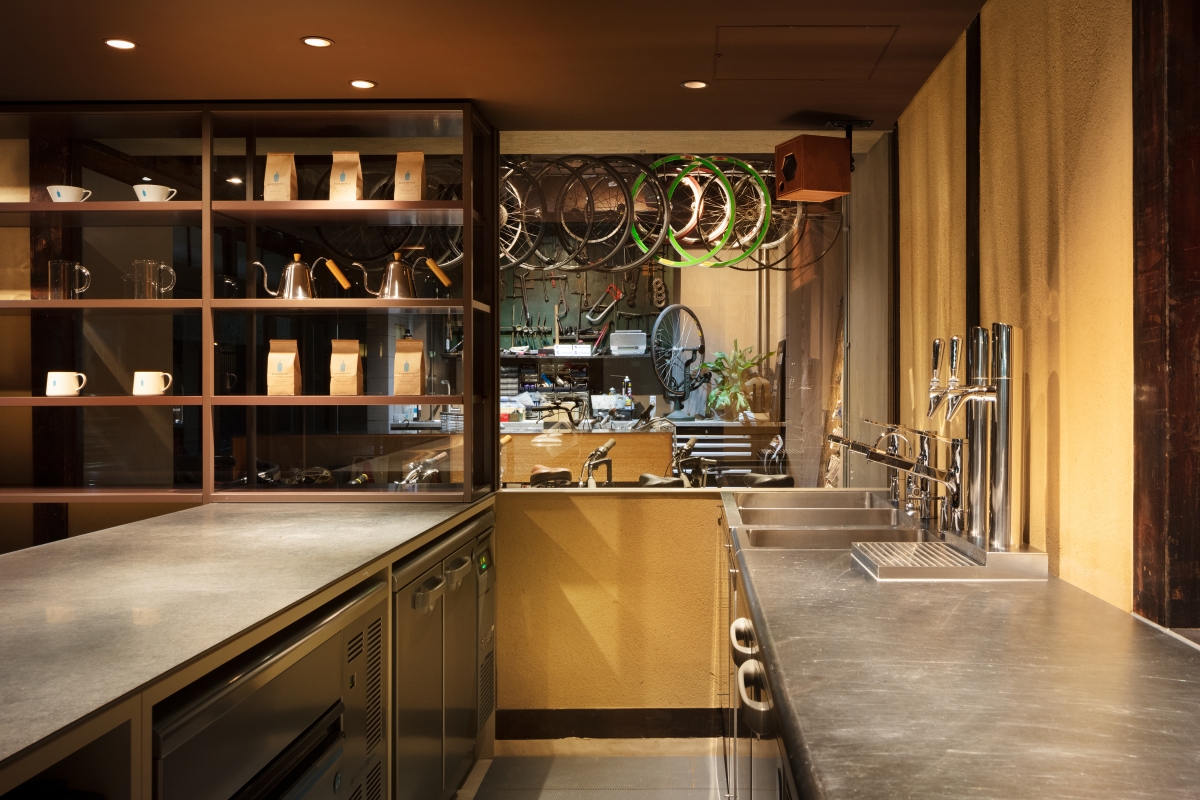
Blue Bottle Coffee Kyoto Rokkaku Cafe
Architect-Induced Individuality
In each of his café designs, Nagasaka ‘considers and proposes materials that match the surrounding region’s atmosphere and original building context’. While consistently following Blue Bottle’s philosophy and style, however, the one thing that he adds variations to is his materials. For example, because the Hong Kong Central Cafe (2020) is situated in an area where the streets often get wet and dirty due to the protruding signs and laundry hanging from the apartment balconies, tiles that are easy to clean and dry were used, and the concrete colouring of these tiles was a deliberate choice for their evocation of a warm ambience. He sometimes proposes new spatial concepts when needed, as he did at the NEWoMan YOKOHAMA Cafe Stand (2020). It is a small takeout café situated next to a bus stop. In such a long and narrow property, Nagasaka managed to turn it into a cosy temporary space by making use of large folding doors. Furthermore, the boxes under the barista’s counter that can either be pushed in or pulled out allow this temporary space to cater flexibly to each customer’s desire as to whether they wish to stand or sit while enjoying a coffee.
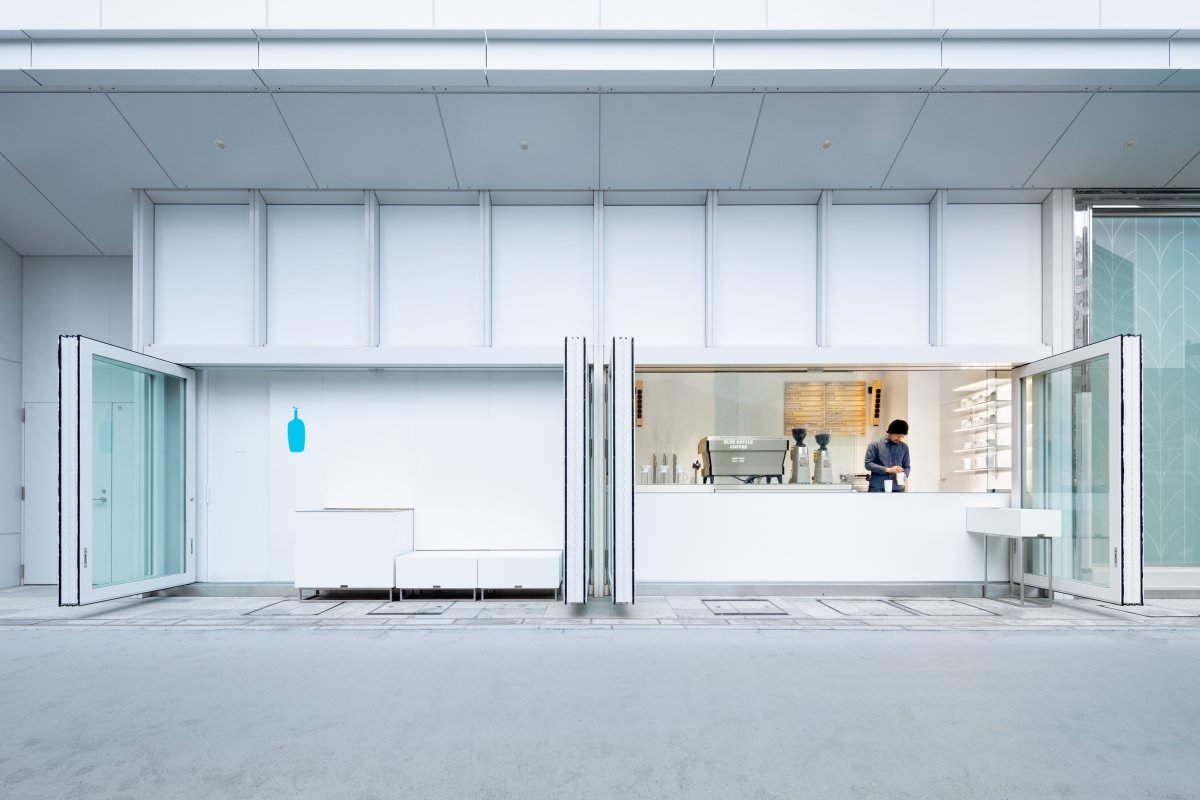
Blue Bottle Coffee NEWoMan YOKOHAMA Cafe Stand
Currently, there are nine local Blue Bottle cafés in business districts and tourist spots such as Yeouido, Gwanghwamun, Jeju, and Myeongdong in Korea. While the Blue Bottle trend that began four years ago in Seongsu-dong and Samcheong-dong developed at a striking rate, when looking back on its new locations and recent history, Blue Bottle cafés in Korea have adopted a somewhat different demeanor when compared to the cafés in the US and Japan. Unlike the abovementioned examples such as Kyoto Rokkaku Cafe that seek to absorb and harmonise with a region’s local character and idiosyncrasies, the cafés in Korea seem somewhat lackluster in terms of reflecting their surroundings. Between the mega chain café and the small neighbourhood café, as two extremes, the most fitting classification for Blue Bottle seems to be somewhere in the middle. But this middle zone is already occupied by other popular Korean café brands such as TERAROSA COFFEE, BEAN BROTHERS, and Anthracite Coffee with their large customer base. Furthermore, Starbucks has also shown remarkable spatial initiatives by renovating abandoned theaters in the heart of the market or opening stores in century-old traditional houses, drawing attention to the local community. Wherever its next destination might be, if Blue Bottle wants to carve out and secure a place of its own in the midst of such competitors, I believe that it would need to demonstrate its brand identity and niche more clearly by developing a model that is evidently Korean.
You can see more information on the SPACE No. 666 (May 2023).






